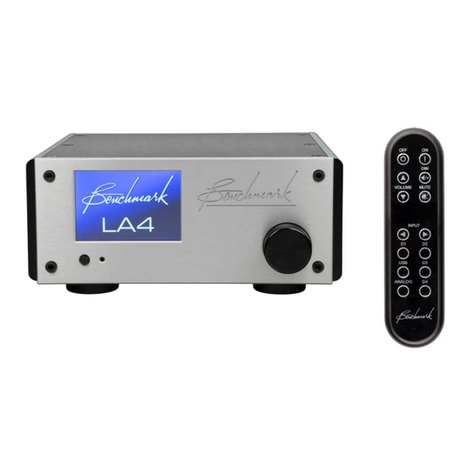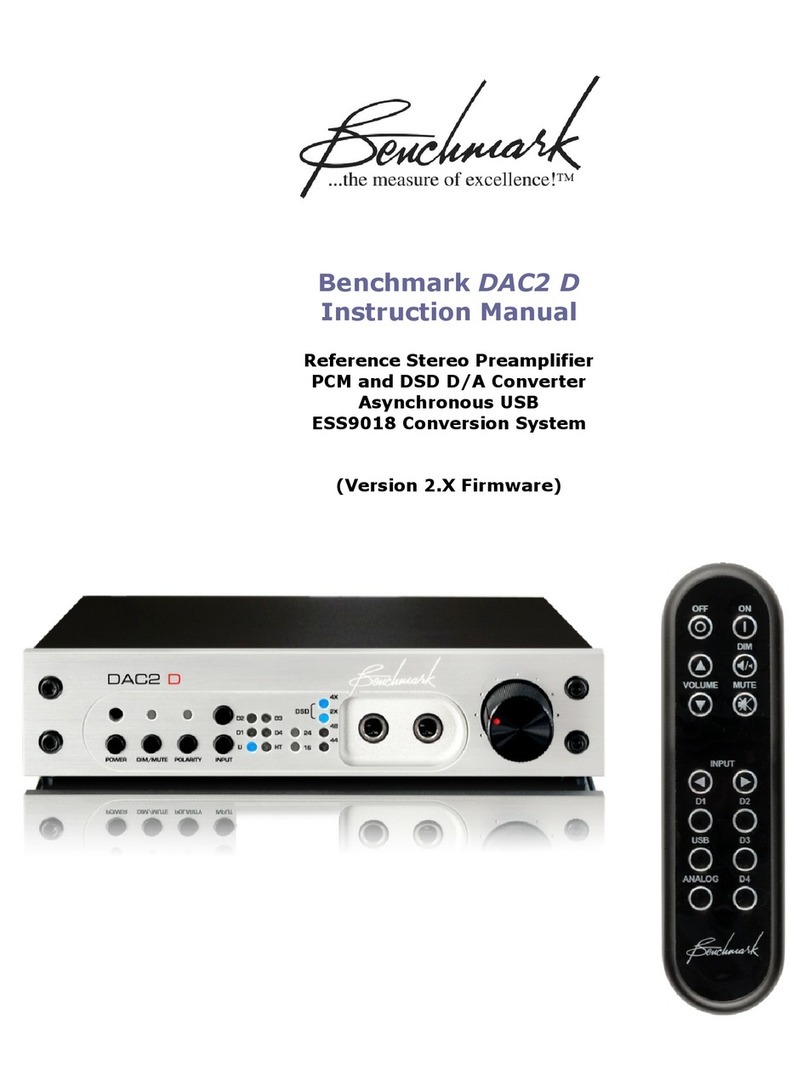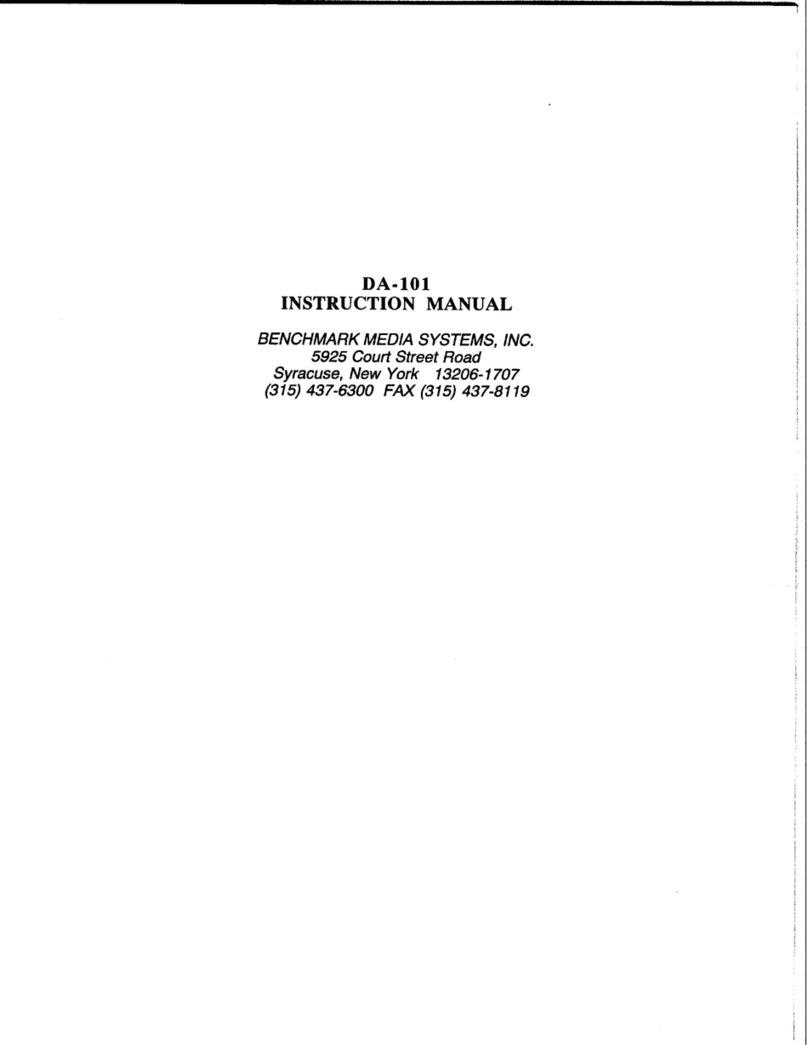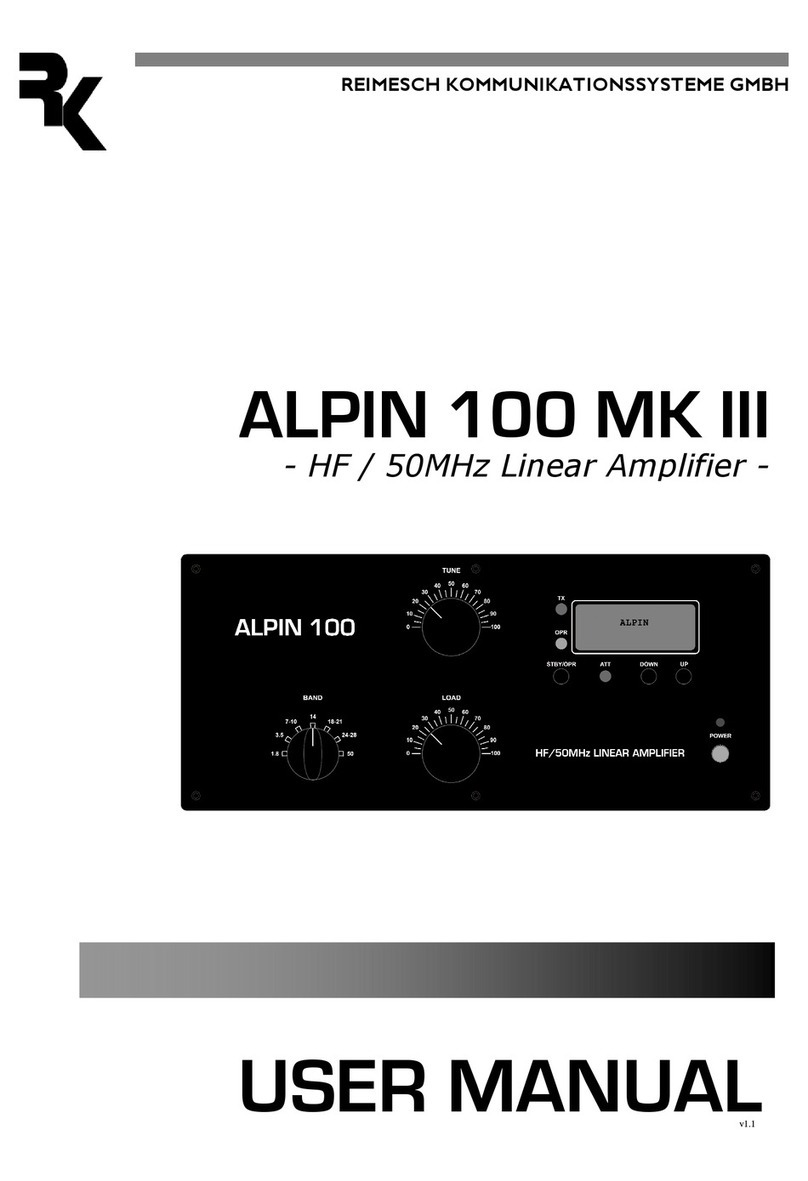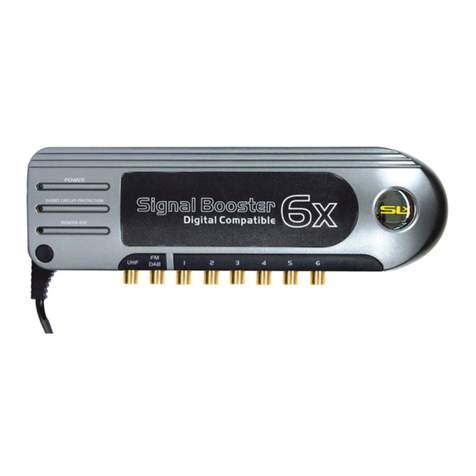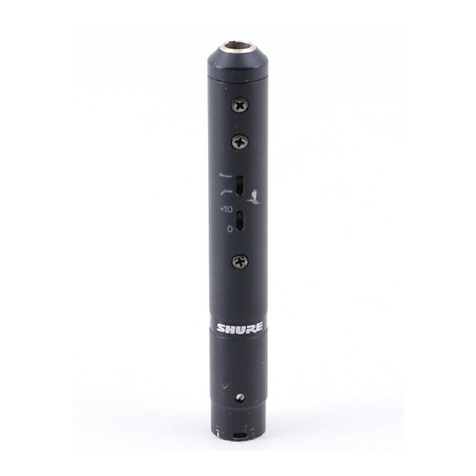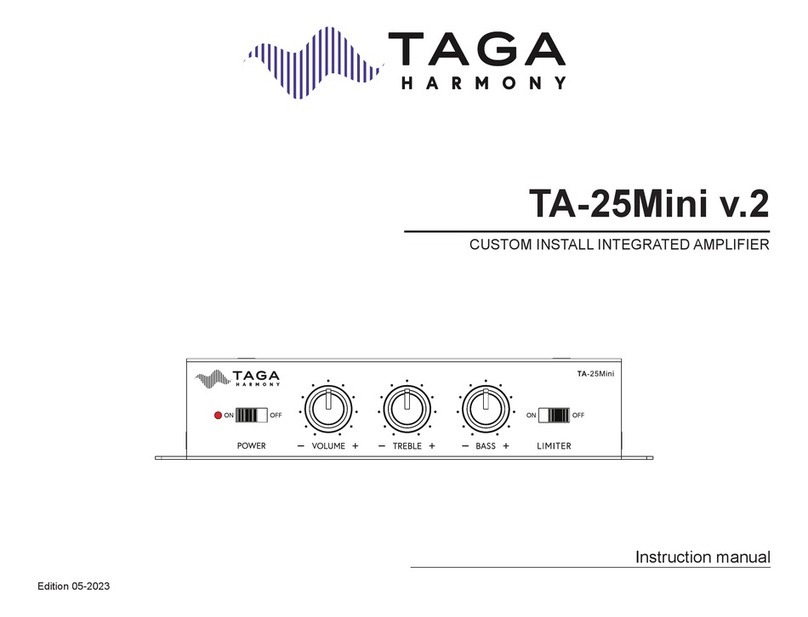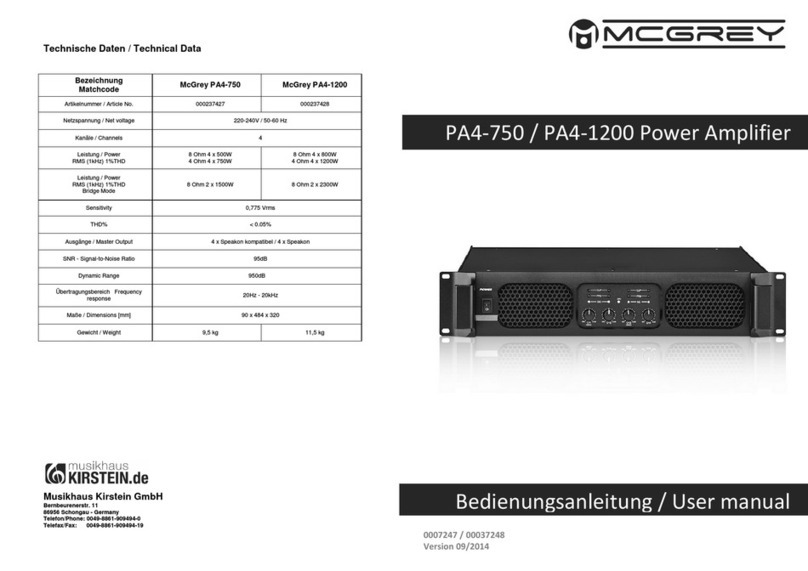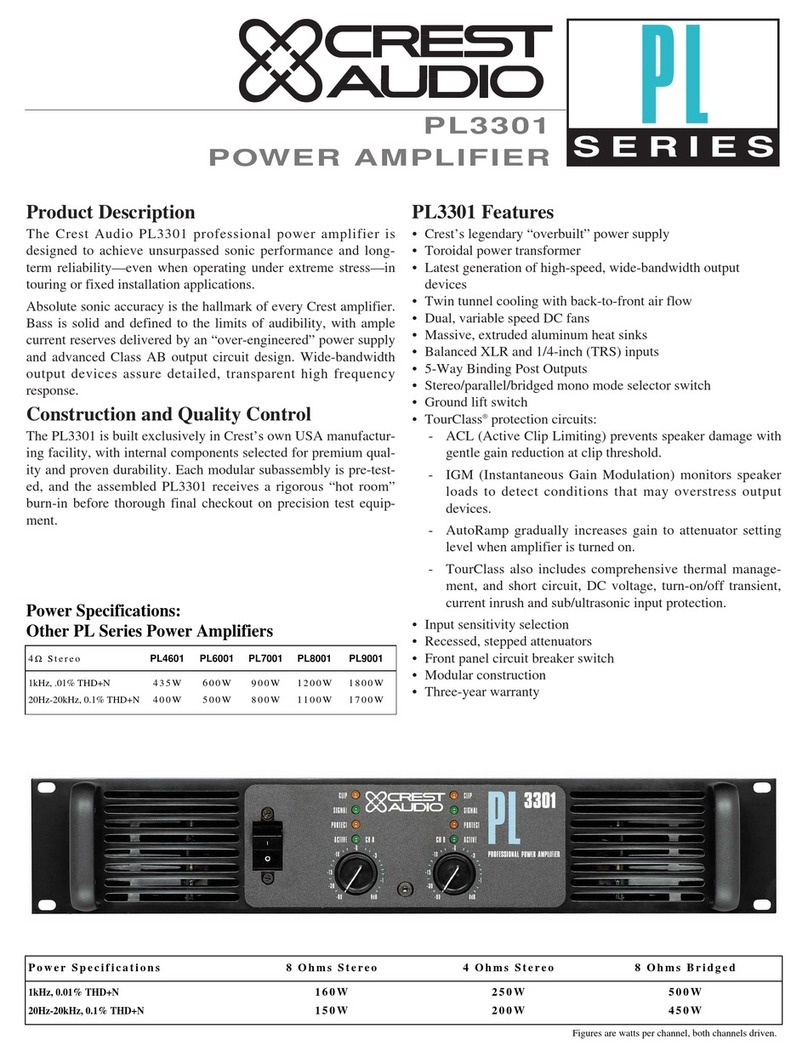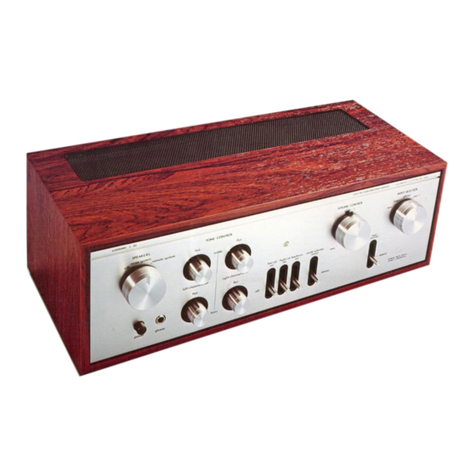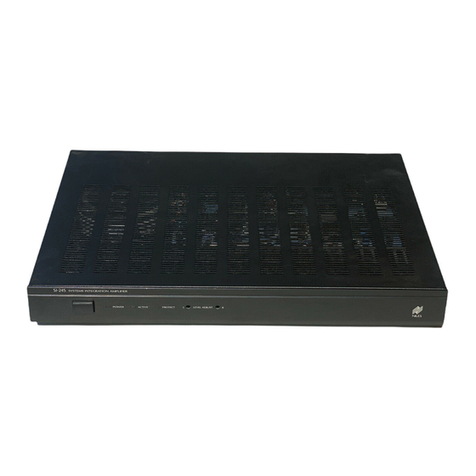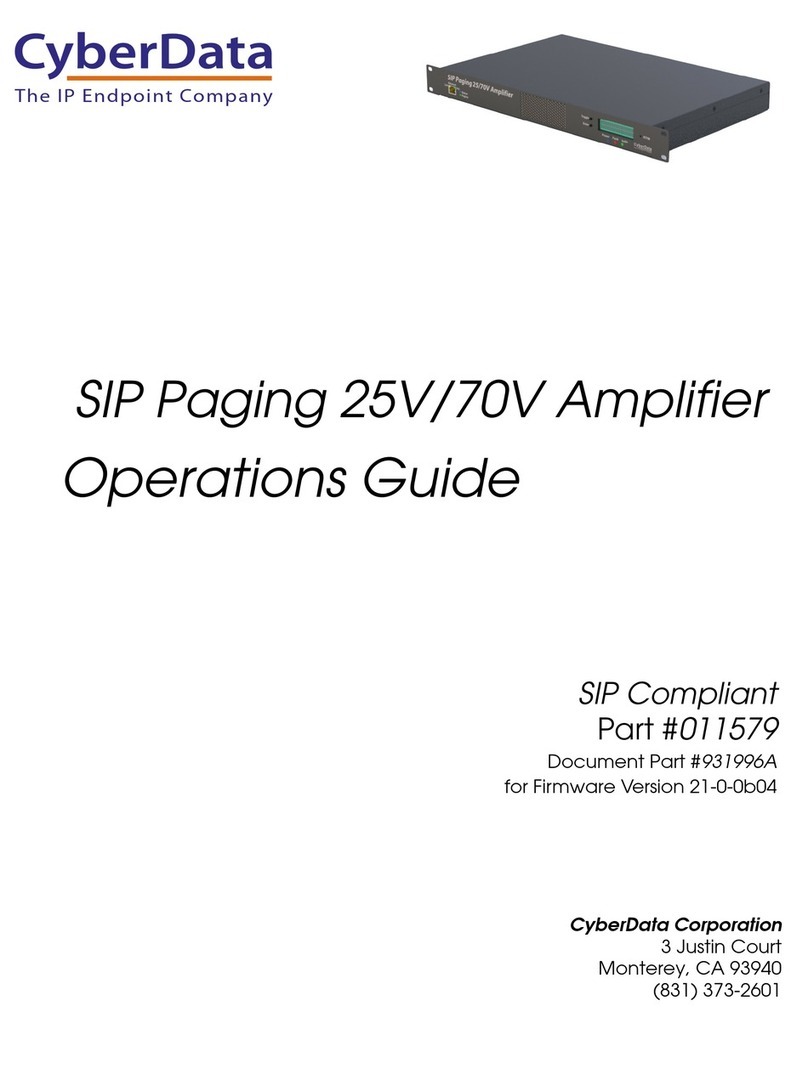Benchmark MPA1 User manual

Benchmark MPA1
Instruction Manual
2-Channel Microphone Preamplifier

Safety Information
Voltage Selection
CAUTION: THE FUSE DRAWER INCLUDES
A VOLTAGE SELECTION SWITCH WITH
TWO SETTINGS: “110” AND “220”.
CHECK TO SEE THAT IT IS PROPERLY
CONFIGURED FOR YOUR LOCATION
BEFORE CONNECTING AC POWER.
Incorrect configuration may blow fuses or
cause erratic operation.
Repairs
CAUTION: DO NOT SERVICE OR REPAIR
THIS PRODUCT UNLESS PROPERLY
QUALIFIED. ONLY A QUALIFIED
TECHNICIAN SHOULD PERFORM
REPAIRS.
Fuses
CAUTION: FOR CONTINUED FIRE
HA ARD PROTECTION ALWAYS REPLACE
THE FUSES WITH THE CORRECT SI E
AND TYPE (0.5A 250 V SLO-BLO
®
5 X 20
MM – LITTELFUSE® HXP218.500 OR
EQUIVALENT).
Modifications
CAUTION: DO NOT SUBSTITUTE PARTS
OR MAKE ANY MODIFICATIONS
WITHOUT THE WRITTEN APPROVAL OF
BENCHMARK MEDIA SYSTEMS, INC.
MODIFICATION MAY CREATE SAFETY
HA ARDS AND VOID THE WARRANTY.
NOTICE: CHANGES OR MODIFICATIONS
NOT EXPRESSLY APPROVED BY
BENCHMARK MEDIA SYSTEMS COULD
VOID THE USER'S AUTHORITY TO
OPERATE THE EQUIPMENT UNDER FCC
REGULATIONS.

Contents
Safety Information 2
Voltage Selection 2
Repairs 2
Fuses 2
Modifications 2
Contents 3
O er iew 4
Features 5
Connections 6
Microphone Inputs (L and R 6
Balanced XLR Outputs 6
Output Signal Levels 7
Driving Unbalanced Loads 7
AC Power Entry Connector 7
Fuse Holder 7
Preamp Section 8
Preamp Overview 8
Microphone Gain Controls 8
Input Topology 8
Two-Stage RF Filter and CMRR 8
Phantom Power Switches 9
Input Protection 9
Polarity Switch 9
40 Hz High-Pass Filters 9
LED Output Level Meters 10
HPA2™ Headphone Output 11
“0-Ohm” Output Impedance 11
Headphone Performance 11
Rack Mounting 12
System1™ Universal Rack Adapter 12
Blank Rack Panel 12
Mounting Near Other Equipment 12
Performance Graphs 13
Frequency Response 13
High-Pass Filter - Frequency Response 14
Inter-Channel Phase Response 15
THD+N vs. Frequency 16
Wideband THD+N vs. Frequency 17
Equivalent Input Noise vs. Gain 18
Noise Spectrum 19
THD Spectrum at 1 KHz 20
THD Spectrum at 10 KHz 21
Specifications 22
Microphone Preamps 22
Direct Outputs 23
HPA2™ Headphone Amplifier 23
LED Output Meters and Gain Indicators 24
AC Power Requirements 24
Dimensions 25
Weight 25
Regulatory Compliance 26
FCC Notice (U.S. Only 26
RoHS Compliant Information 26
CE Certificate of Conformity 27
Warranty Information 28
Benchmark Extended Warranty 29
Calibration 30
+48V Adjustment 30

MPA1 Instruction Manual Page 4
Overview
The MPA1 is a 2-channel microphone
preamplifier that is designed to achieve the
highest performance available in a
microphone preamplifier. The MPA1 is
designed for maximum transparency, wide
bandwidth, low-noise, low-distortion, and
superior EMI immunity. It is well suited for
the most demanding applications in studios
and live venues.
The MPA1 is the next evolution of
Benchmark’s legendary microphone
preamplifier systems. In all respects, the
MPA1 meets or exceeds the performance of
Benchmark’s current and legacy mic preamps.
The MPA1 achieves outstanding performance
over a wide range of input levels. Gain is
controlled by precision matched switched
resistor networks and is adjustable over a
range of 0 dB to 74 dB without using a pad.
Each channel of the MPA1 has an XLR direct
output. These outputs feature low-distortion,
high-current drivers that easily handle long
cables and other less-than-ideal loads.
Each of the MPA1's two channels includes a
switch for +48V Phantom power, polarity
inversion, and a 40Hz high-pass filter.
The entire MPA1 has a 500 kHz bandwidth.
Wide bandwidth demands exceptional RF
filtering and shielding: The multi-layer printed
circuit board uses a special construction
technique that creates a 3-dimensional shield
surrounding all signal traces. Each
microphone input features Benchmark’s
exclusive precision-tuned, two-stage RF input
filter. This circuit removes RF interference
without affecting the microphone input signal.
RF filters have always been a key component
in Benchmark preamps, and has resulted in a
proven track record for exceptional
performance in difficult high-RF venues.
Microphone pre-amplifier circuits usually
suffer from non-linear performance at ultra-
sonic frequencies. This non-linearity causes
inter-modulation distortion (IMD components
that fold down to audible frequencies. Unlike
harmonic distortion (THD , IMD produces
distortion tones that are very un-natural and
non-musical. IMD also masks and alters the
subtle details of delicate high-frequency
transients such as those produced by bells.
Benchmark preamps have always had
outstanding high-frequency performance as
well as freedom from IMD. The MPA1 takes
the Benchmark design one step further, and
achieves the lowest IMD that we have ever
measured in a microphone preamplifier.
The MPA1 includes the HPA2™ - Benchmark's
signature high-current, 0-Ohm headphone
amplifier. The HPA2™ is capable of delivering
the full performance of the MPA1 into the
difficult load presented by most headphones.
A rugged half-rack (½ RU enclosure includes
an internal power supply that supports all
international voltages and has generous
margins for over-voltage and under-voltage
conditions. It features a core-banded toroidal
transformer in a shielded enclosure.
We believe that you will enjoy the
performance and features of the MPA1.

MPA1 Instruction Manual Page 5
Features
• Two Transformerless Microphone Inputs
• Two Balanced Direct Outputs (XLR
• Monolithic Low-Noise Transistor Quads on Each Microphone Input
• Precision-Tuned, Two-Stage RF Filter on Each Microphone Input
• Precision-Matched Resistor Gain Control Switches on Every Microphone Input
• 2-dB per Switch Step; Maximum Gain - 74 dB; Maximum Gain - 0 dB (Unity
• ‘Virtual’ 38-position Gain Control Switch for Continuous Gain Control
• Four Segment Gain Range Indicator
• +27.5 dBu Maximum Input Level
• +27.5 dBu Maximum Output Level on Balanced Outputs
• Actively Balanced Transformerless Outputs
• High-Current High-Speed Low-Capacitance Phantom Protection Circuits
• Fully Protected Against Phantom Hot-Plug and Cable-Shorting Scenarios
• Phantom-Disable Feature for Dedicated Ribbon Microphone Application
• +48v Phantom Power Switch on Every Microphone Input
• 40 Hz High-Pass Filter Switch on Every Microphone Input (12 dB/octave
• Polarity Switch on Every Microphone Input
• Four-Segment LED Output Level Meter (-20 dBu, +4 dBu, +24 dBu, +29 dBu
• HPA2™ “0-Ohm” 1/4” TRS Headphone Output
• +23.5 dBu Maximum Headphone Output Level
• 41-Detent Headphone Level Control
• Ultra-Quiet Linear Power Supply with Rear-Panel Input Voltage Selector
• Complies with FCC and CE Regulations
• RoHS Compliant

MPA1 Instruction Manual Page 6
Connections
Microphone Inputs (L and R)
The balanced transformerless microphone
inputs use locking Neutrik™ gold-pin female
XLR jacks with both pin 1 (Ground and the
XLR shell directly bonded to the chassis. This
direct bonding is important for maximum RF
shielding and for immunity to hum due to
shield currents. Each input includes
Benchmark’s precision-tuned, two-stage RF
filter for outstanding RF immunity.
• XLR pin 2 = + Audio In
• XLR pin 3 = - Audio In
• XLR pin 1 = Cable Shield – bonded to
chassis
• XLR shell – bonded to chassis
The microphone inputs have a wide operating
range. The maximum input level before
clipping is +29 dBu.
Each channel is equipped with a switch for
+48V phantom power. Under certain
circumstances, phantom power can cause
large voltage transients. The MPA1 is
equipped with high-current input protection
circuits that protect the sensitive low-noise
input transistors from the worst-case
phantom-induced transients. Large transients
are produced when a microphone is
connected or disconnected while phantom
power is on. The worst possible transients
occur when a microphone cable has an
intermittent short to ground from either pin 2
or pin 3. The MPA1 is very well protected
against both of the above. For the protection
of your equipment (and your ears , we
strongly recommend shutting off phantom
power several seconds before connecting or
disconnecting a microphone.
The MPA1 is designed to work with balanced
microphones, balanced line-level inputs, and
unbalanced sources as well. The MPA1
maintains rock-solid performance even in
difficult RF environments.
Common-mode signals in the audio band are
removed with a precisely trimmed differential
amplifier. The MPA1 even includes a subsonic
common-mode trim adjustment on each
microphone input that eliminates sensitivity
to +48V ripple caused by power supply noise
and/or the loading of microphone electronics.
Balanced XLR Outputs
The MPA1 has two balanced direct outputs.
These outputs use gold-pin Neutrik™ male
XLR connectors with direct chassis bonding of
both pin 1 and the connector shell. This
direct bonding is important for maximum RF
shielding and for immunity to hum due to
shield currents.
All outputs are transformerless and have an
impedance of 60 Ohms balanced or 30 Ohms
unbalanced. All outputs are equipped with
high-performance drivers that can drive high
signal levels into load impedances as low as
300 Ohms without an increase in distortion.
These outputs are well suited for driving long
lines.
XLR pin 2 = + Audio Out
XLR pin 3 = - Audio Out
XLR pin 1 = Cable Shield – bonded to chassis
XLR shell – bonded to chassis

MPA1 Instruction Manual Page 7
Output Signal Le els
The maximum output level on the balanced
outputs is +27.5 dBu. Each channel’s output
can be monitored with the four-segment LED
output level meter.
Dri ing Unbalanced Loads
CAUTION: ALWAYS LEAVE XLR PIN 3
FLOATING WHEN DRIVING UNBALANCED
LOADS.
XLR to RCA Wiring:
1. Connect XLR pin 2 (+ to RCA center pin.
2. Connect XLR pin 1 (GND to RCA shield.
3. Make no connection to XLR pin 3 (- .
XLR to ¼” TS Wiring:
1. Connect XLR pin 2 (+ to Tip.
2. Connect XLR pin 1 (GND to Sleeve.
3. Make no connection to XLR pin 3 (- .
AC Power Entry Connector
The AC power input uses a standard IEC type
connector and includes a power switch.
Factory-configured 110V units ship with a
power cord. 220V units ship without a power
cord. Location-specific IEC style power cords
may be purchased from a local source
(including any local Benchmark dealer .
Fuse Holder
The fuse holder is built into a drawer next to
the IEC power connector. The drawer requires
two 5 x 20 mm 250 V Slo-Blo
®
Type fuses.
The drawer includes a voltage selection switch
with two settings: “110” and “220”. Both
settings use a 0.5 Amp fuse.
The AC input has a very wide input voltage
range and can operate over a frequency
range of 50 to 60 Hz. At the “110” setting,
the MPA1 will operate normally over a range
of 105 to 140 VAC. At the “220” setting, the
MPA1 will operate normally over a range of
200 to 285 VAC.
CAUTION: FOR CONTINUED FIRE
HA ARD PROTECTION ALWAYS REPLACE
THE FUSES WITH THE CORRECT SI E
AND TYPE (0.5A 250 V SLO-BLO
®
5 X 20
MM – LITTELFUSE® HXP218.500 OR
EQUIVALENT).

MPA1 Instruction Manual Page 8
Preamp Section
Preamp O er iew
Each preamp channel includes switches for
phantom power, polarity, and 40 Hz high-
pass filter. Each channel also has a 38-
position gain control switch and a 4-segment
output level meter. Inputs are fully protected
against overloads and phantom power
transients.
Microphone Gain Controls
The gain controls are a unique approach to
the popular switched-resistor network
topology. Each gain switch of the MPA1 can
sweep the entire 74 dB gain range with
continuous rotation. This is achieved with a
‘virtual 38-position’ switch – a 13-position
switch that triggers automatic adjustment of
the gain-range.
These resistor networks are precision-
matched for inter-channel gain matching
within +/- 0.03 dB. This precision provides
precise control of stereo microphone pairs.
Maximum gain is calibrated for exactly 74 dB.
Minimum gain is 0 dB (unity . The MPA1 does
not attenuate the signal with pads or
otherwise. When the gain is set at 0 dB, the
MPA1 can accept a signal at +27.5 dBu
without clipping.
Input Topology
The first gain stage on each microphone input
is built around precision-matched, monolithic,
low-noise transistor quads. Bandwidth is 500
kHz, IMD and THD are virtually non-existent.
The MPA1 is designed to achieve faithful and
transparent microphone amplification.
Two-Stage RF Filter and CMRR
Each microphone input is precision-trimmed
at 3 frequencies for common-mode rejection.
High-frequency RF interference is blocked by
Benchmark’s two-stage RF filter. This filter
maintains the MPA1’s outstanding
performance in very difficult RF
environments.

MPA1 Instruction Manual Page 9
Phantom Power Switches
Up = Phantom On
Down = Phantom Off
CAUTION: ALWAYS TURN OFF PHANTOM
POWER AND WAIT SEVERAL SECONDS
BEFORE CONNECTING OR
DISCONNECTING MICROPHONES.
The MPA1 has an internal ‘Phantom Defeat’
jumper. When this jumper is removed,
phantom power cannot be applied to the
respective microphone input. This feature
should be used when the MPA1 is dedicated
to ribbon microphone. The purpose is to
protect the ribbon element in case the +48V
switch is thrown. The internal ‘Phantom
Defeat’ jumper is located behind the left
channel’s +48V switch (bottom-left in the
following picture .
CAUTION: ALWAYS DISCONNECT POWER
FROM THE MPA1 FOR FIVE MINUTES
BEFORE ADJUSTING THE PHANTOM
DEFEAT JUMPER.
Input Protection
Under certain circumstances, phantom power
can cause large voltage transients. The MPA1
is equipped with high-speed, high-current,
low-capacitance protection circuits that
protect the sensitive input-transistors from
the worst-case phantom-induced transients.
Large transients are produced when a
microphone is connected or disconnected
while phantom power is on. The worst
possible transients occur when a microphone
cable has an intermittent short to ground
from either pin 2 or pin 3. The MPA1 is very
well protected against both of the above. For
the protection of your microphones (and your
ears , we strongly recommend shutting off
phantom power several seconds before
connecting or disconnecting a microphone.
Polarity Switch
Up = Polarity is Inverted
Down = Polarity is Normal
The polarity switch allows the polarity of the
input signal as to be easily reversed. Typical
applications that require polarity inversion
include using the back-side of a figure-8
microphone (such as a ribbon , having two
microphones on one instrument but facing
opposite directions, or when a microphone or
cable is constructed with inverted polarity.
40 Hz High-Pass Filters
Up = Filter Enabled
Down = Filter Off
The 40 Hz high-pass filter is a second-order
filter with a slope of 12 dB per octave. This
filter is intended to remove unwanted
subsonic noise and rumble caused by sources
such as HVAC, air currents, and vibration.

MPA1 Instruction Manual Page 10
LED Output Le el Meters
Each preamp channel is equipped with a four-
segment LED output level meter.
The LED’s are driven by a peak detection and
stretching circuit so that very short transients
can be observed.
The first green LED (-20 dBu illuminates
when the output signal has an amplitude of at
least -20 dBu.
The second green LED (+4 dBu illuminates at
an output level of at least +4 dBu.
The yellow LED (+24 dBu illuminates at an
output level of at least +24 dBu.
The red LED (+28 dBu illuminates at an
output level of at least +27.5 dBu. The red
LED indicates a clip has occurred.

MPA1 Instruction Manual Page 11
HPA ™ Headphone
Output
The output of each channel’s preamp is
directed to the headphone amplifier,
Benchmark’s signature HPA2™ headphone
amplifier. This high-current, high-output
amplifier has an output impedance of 0-
Ohms. It is designed to drive loads as low as
30-Ohms without any increase in distortion.
It also has sufficient amplitude to drive low-
sensitivity 600-Ohm headphones.
The HPA2™ includes current-limiting circuits
that fully protect against damage from short
circuits. This is important because the right
channel of a headphone amplifier will
experience a short whenever a mono phone
plug is inserted into the stereo headphone
jack. Shorts may also occur when a plug is
partially inserted.
“0-Ohm” Output Impedance
Most headphone amplifiers use series
resistors to maintain stability and protect
against short-circuit conditions. These
resistors are usually at least 30-Ohms, and
have a negative impact on performance. A
headphone amplifier with series resistors may
measure very well when driving resistive
loads. However, the same amplifier will
measure very poorly when driving a
headphone load. Unfortunately most
manufacturers do not specify headphone
amplifier performance with anything other
than ideal resistive loads. Our measurements
show that headphones do not behave like
resistive loads.
Headphone Performance
In our tests we have measured substantial
distortion across resistors that are wired in
series with headphones. We conducted
measurements with a variety of headphones.
In general, distortion increases as headphone
impedance decreases. This distortion can be
eliminated with a properly designed 0-Ohm
headphone amplifier.
The performance of the HPA2™ does not
change when headphones are driven. THD+N
measurements for no-load, 30-Ohm resistive
load, and 30-Ohm headphone load, and 600-
Ohm headphone load are virtually identical.
The HPA2™ will substantially improve the
sound of 30 and 60-Ohm headphones. It will
make very noticeable improvements with
600-Ohm headphones.

MPA1 Instruction Manual Page 12
Rack Mounting
There are multiple solutions for rack-
mounting the MPA1. An optional Rack-
Mount Coupler allows the mounting of any
two Benchmark System1™ products in a
single rack space. A Blank Rack Panel can
be added when only one unit is being racked.
The System1™ Universal Rack Adapter is
a tray solution.
These rack-mount solutions are available
from Benchmark. Call us, visit our website
(http://www.BenchmarkMedia.com , or
contact your dealer to purchase these
accessories.
System1™ Uni ersal Rack
Adapter
The Universal Rack Mount Adapter is a
tray that mounts up to two System1™
products in a single race space. The tray
accepts any combination of System1™
products (with or without rack-mount type
faceplates .
Blank Rack Panel
The Blank Rack Panel is a ½-wide 1-RU
black-anodized aluminum panel for covering
an unused slot in a System1™ Universal
Rack Adapter.
Mounting Near Other
Equipment
CAUTION: STRAY MAGNETIC FIELDS
FROM ADJACENT EQUIPMENT MAY
CAUSE MAGNETICALLY INDUCED HUM IN
THE SENSITIVE HIGH-GAIN PREAMP
CIRCUITS.
The MPA1 is shielded in 3-dimensions with
mu-metal panels, which drastically reduces
susceptibility to stray magnetic fields. The
MPA1 may be mounted directly above or
below any other equipment, but we cannot
guarantee that the MPA1 will be impervious to
interference from all equipment mounted too
close to the MPA1. It is recommended that
the user apply caution by using the following
procedure when mounting near other
equipment:
TIP: TO CHECK FOR MAGNETIC
INTERFERENCE FROM ADJACENT
EQUIPMENT:
1. Disconnect all microphones
2. Back-terminate microphone inputs
3. Set all preamp gain controls at maximum
4. Listen to headphone output
5. Unplug adjacent equipment to determine
if there is any magnetic interference
TIP: IN MANY CASES, POWER SWITCHES
DO NOT TURN OFF ALL OF THE
MAGNETIC COMPONENTS IN AN
ELECTRONIC DEVICE. THEREFORE, WHEN
PERFORMING MAGNETIC INTERFERENCE
TESTS, IT IS IMPORTANT TO UNPLUG
THE ADJACENT EQUIPMENT TO INSURE
THAT THESE DEVICES ARE TRULY OFF.

MPA1 Instruction Manual Page 13
Performance Graphs
Frequency Response
Audio Precision
02/19/07 11:33:00PRE420 - Frequency Response
ColorS eep Trace Line Style Thick Data Axis Comment
1 1 Red Solid 4 Anlr.Level A Left HP Filter Off
-3
+3
-2.8
-2.6
-2.4
-2.2
-2
-1.8
-1.6
-1.4
-1.2
-1
-0.8
-0.6
-0.4
-0.2
+0
+0.2
+0.4
+0.6
+0.8
+1
+1.2
+1.4
+1.6
+1.8
+2
+2.2
+2.4
+2.6
+2.8
d
B
r
A
10 200k20 50 100 200 500 1k 2k 5k 10k 20k 50k 100k
Hz
The above graph shows the frequency response of the MPA1 with the 40 Hz high-pass filter off. The
amplitude response measures -0.020 dB at 10 Hz and -0.165 dB at 200 kHz. The bass response
extends well below the 10-Hz limitation of the test equipment, and the high-frequency response
extends well above the 200 kHz limit of the test equipment.

MPA1 Instruction Manual Page 14
High-Pass Filter - Frequency Response
Audio Precision
02/19/07 11:33:00PRE420 - Frequency Response
ColorS eep Trace Line Style Thick Data Axis Comment
2 1 Red Solid 4 Anlr.Level A Left HP Filter On
-3
+3
-2.8
-2.6
-2.4
-2.2
-2
-1.8
-1.6
-1.4
-1.2
-1
-0.8
-0.6
-0.4
-0.2
+0
+0.2
+0.4
+0.6
+0.8
+1
+1.2
+1.4
+1.6
+1.8
+2
+2.2
+2.4
+2.6
+2.8
d
B
r
A
10 200k20 50 100 200 500 1k 2k 5k 10k 20k 50k 100k
Hz
The above graph shows the response of the 40 Hz high-pass filter. Response is -3 dB at 40 Hz with
a slope of 12 dB/octave.

MPA1 Instruction Manual Page 15
Inter-Channel Phase Response
Audio Precision
02/19/07 11:35:37PRE420 - Inter-Channel Phase Response
-1
+1
-0.9
-0.8
-0.7
-0.6
-0.5
-0.4
-0.3
-0.2
-0.1
+0
+0.1
+0.2
+0.3
+0.4
+0.5
+0.6
+0.7
+0.8
+0.9
d
e
g
10 100k20 50 100 200 500 1k 2k 5k 10k 20k 50k
Hz
This graph shows that the differential phase is significantly better than ± 0.05 degrees from 10 Hz
to 20 kHz.

MPA1 Instruction Manual Page 16
THD+N s. Frequency
Measurement Bandwidth = 10Hz to 80 kHz, Gain = 30 to 60 dB, Output Leve = +4 dBu
Audio Precision
02/21/07 09:56:41PRE420 - THD+N vs Frequency at 60 dB Gain, BW=80 kHz
ColorS eep Trace Line Style Thick Data Axis Com ment
1 1 Red Solid 4 Anlr.THD+N Ratio Left 60 dB Gain (top trace)
2 1 Magenta Solid 4 Anlr.THD+N Ratio Left 50 dB Gain
3 1 Blue Solid 4 Anlr.THD+N Ratio Left 40 dB Gain
4 1 Green Solid 4 Anlr.THD+N Ratio Left 30 dB Gain (bottom trace)
0.0001
0.01
0.0002
0.0005
0.001
0.002
0.005
%
-120
-80
-118
-116
-114
-112
-110
-108
-106
-104
-102
-100
-98
-96
-94
-92
-90
-88
-86
-84
-82
d
B
20 80k50 100 200 500 1k 2k 5k 10k 20k 50k
Hz
This graph shows that THD+N does not rise with frequency – even at maximum gain.

MPA1 Instruction Manual Page 17
Wideband THD+N s. Frequency
Measurement Bandwidth = 10 Hz to 500 kHz, Gain = 30 to 60 dB, Output Leve = +4 dBu
Audio Precision
02/19/07 16:16:11PRE420 - Wideband THD+N vs Frequency, BW=500 kHz
ColorS eep Trace Line Style Thick Data Axis Com ment
1 1 Red Solid 4 Anlr.THD+N Ratio Left 60 dB Gain (top trace)
2 1 Magenta Solid 4 Anlr.THD+N Ratio Left 50 dB Gain
3 1 Blue Solid 4 Anlr.THD+N Ratio Left 40 dB Gain
4 1 Green Solid 4 Anlr.THD+N Ratio Left 30 dB Gain (bottom trace)
0.001
0.1
0.002
0.005
0.01
0.02
0.05
%
-100
-60
-98
-96
-94
-92
-90
-88
-86
-84
-82
-80
-78
-76
-74
-72
-70
-68
-66
-64
-62
d
B
20 200k50 100 200 500 1k 2k 5k 10k 20k 50k 100k
Hz
This graph shows that THD+N does not rise above noise – even at very high frequencies. The 500
kHz measurement bandwidth elevates the noise by 28 dB relative to a 20 kHz measurement
bandwidth.

MPA1 Instruction Manual Page 18
Equi alent Input Noise s. Gain
The above plot shows the Equivalent Input Noise (EIN of the MPA1 as a function of gain.
Measurement bandwidth is 20 Hz to 20 kHz. Input termination is 150 Ohms.

MPA1 Instruction Manual Page 19
Noise Spectrum
32k B-H FFT, Gain = 60 dB, 0 dBr = 0 dBu at input
Audio Precision
02/19/07 11:27:19Noise Spectrum, Gain = 60 dB, 0 dBr = 0 dBu at Input
ColorS eep Trace Line Style Thick Data Axis Comment Cursor1 Cursor2
1 1 Red Solid 4 Fft.Ch.1 Ampl Left *-145.066 dBr A *-149.014 dBr A
-200
+0
-190
-180
-170
-160
-150
-140
-130
-120
-110
-100
-90
-80
-70
-60
-50
-40
-30
-20
-10
-145.066
-149.014
d
B
r
A
10 30k20 50 100 200 500 1k 2k 5k 10k 20k
59.6606 180.657
Hz
dx=120.996 Hz
dy=-3.948 dB
The above graph demonstrates that the MPA1 is free of hum and noise. The highest tone is 60-Hz
line-related hum and is at a level equivalent to an input level of -145 dBu. 180-Hz hum is at an
equivalent input level of -149 dBu.

MPA1 Instruction Manual Page 20
THD Spectrum at 1 KHz
Audio Precision
02/21/07 09:43:491 kHz FFT at 60 dB Gain, Output Level = +24 dBu, 0 dBr = +24 dBu
ColorS eep Trace Line Style Thick Data Axis Comment Cursor1 Cursor2
1 1 Red Solid 4 Fft.Ch.2 Ampl Left *-111.404 dBr A *-122.747 dBr A
-150
-100
-148
-146
-144
-142
-140
-138
-136
-134
-132
-130
-128
-126
-124
-122
-120
-118
-116
-114
-112
-110
-108
-106
-104
-102
d
B
r
A
-150
-100
-148
-146
-144
-142
-140
-138
-136
-134
-132
-130
-128
-126
-124
-122
-120
-118
-116
-114
-112
-110
-108
-106
-104
-102
-111.404
-122.747
d
B
r
A
2k 20k4k 6k 8k 10k 12k 14k 16k 18k
2.00513k3.00537k
Hz
dx=1.00024 kHz
dy=-11.343 dB
The above FFT plot shows that the MPA1 has very little harmonic distortion. The 1 kHz test tone is
notched out with a THD analyzer to improve the resolution of the test. Distortion is exceptionally
low. 2
nd
-harmonic distortion measures better than -111 dB. 3
rd
-harmonic distortion measures
better than -122 dB. Note the absence of higher-order harmonics.
Table of contents
Other Benchmark Amplifier manuals

Benchmark
Benchmark DAC3 HGC User manual
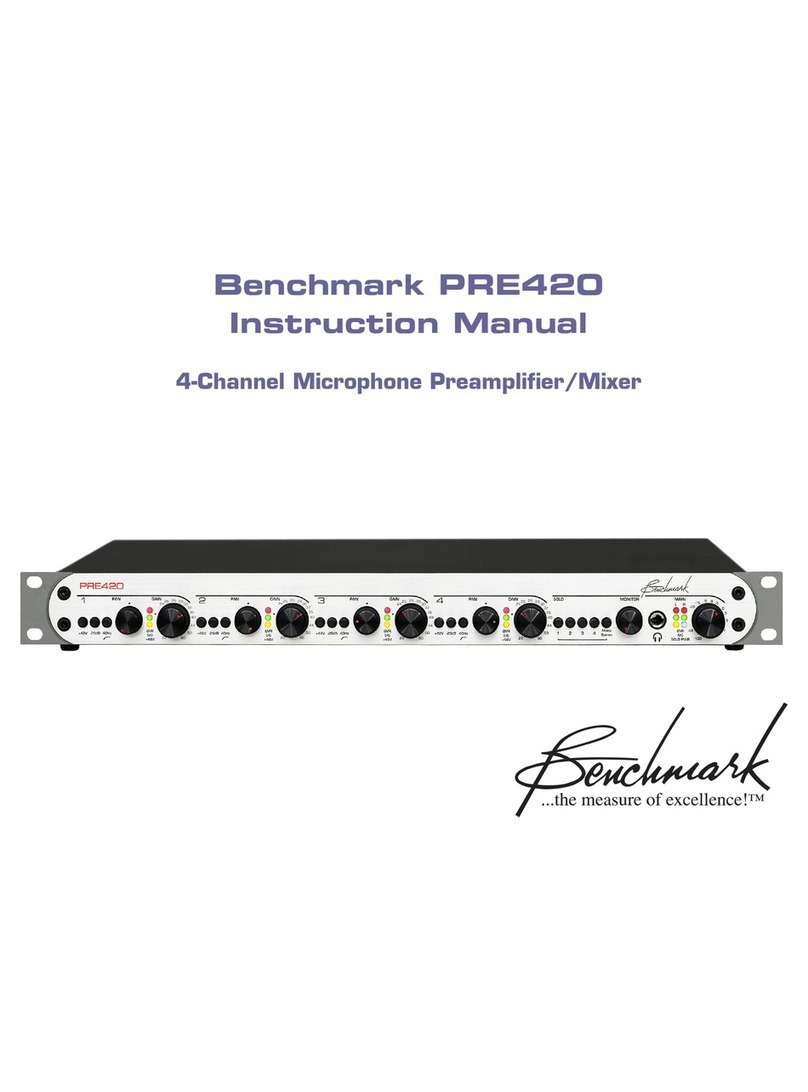
Benchmark
Benchmark PRE420 User manual
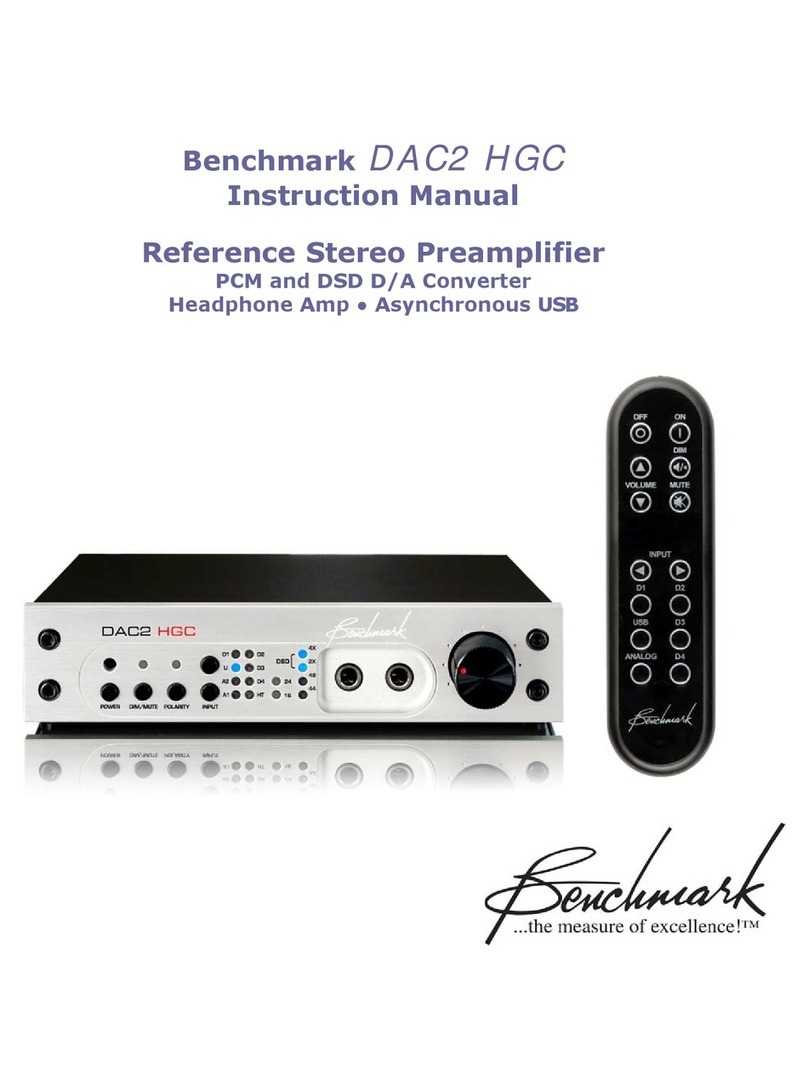
Benchmark
Benchmark DAC2 HGC User manual
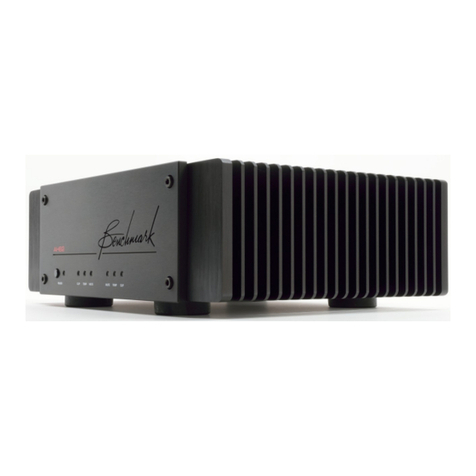
Benchmark
Benchmark AHB2 User manual
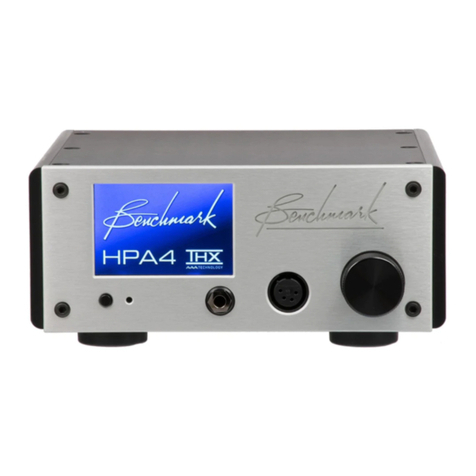
Benchmark
Benchmark HPA4 User manual

Benchmark
Benchmark DAC2 HGC User manual
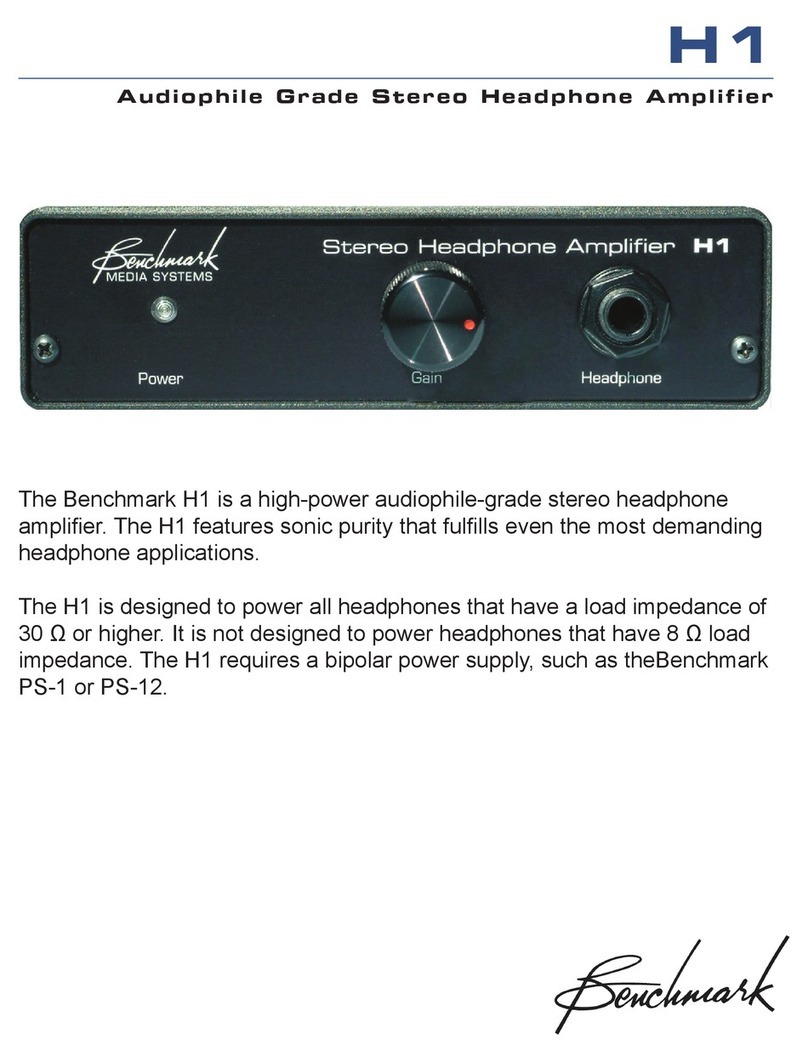
Benchmark
Benchmark h1 User manual
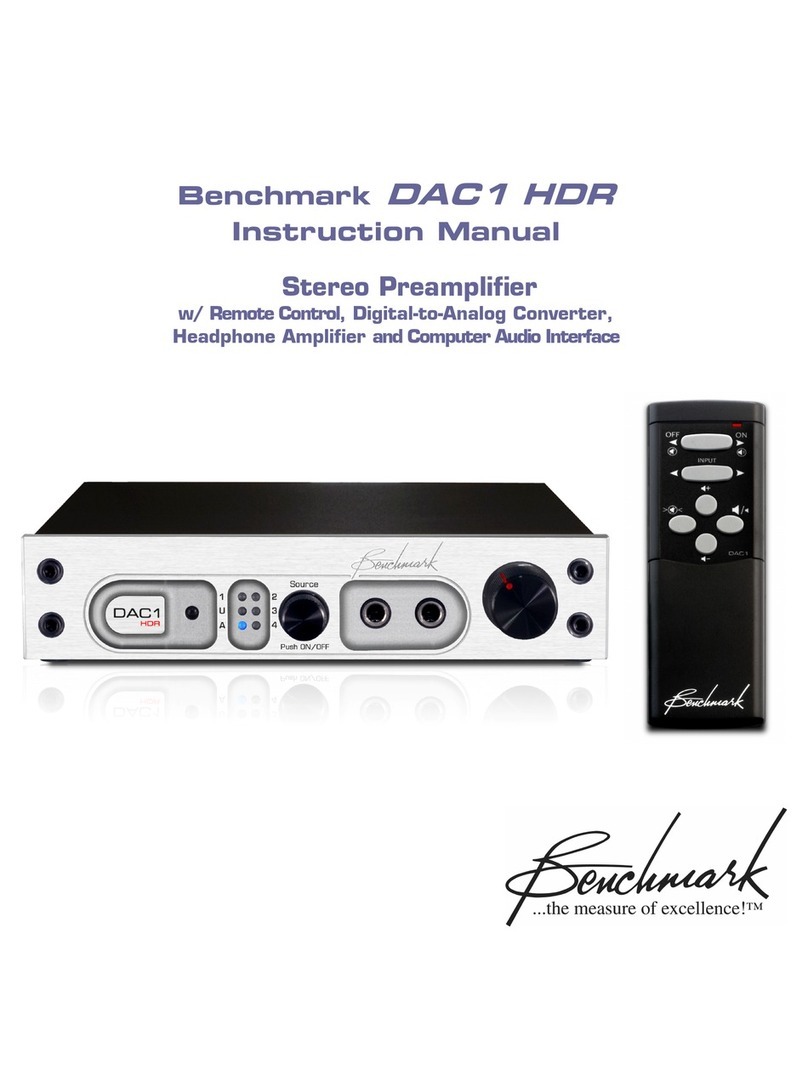
Benchmark
Benchmark DAC1 HDR User manual

Benchmark
Benchmark HPA4 Quick start guide

Benchmark
Benchmark DAC2 HGC User manual
